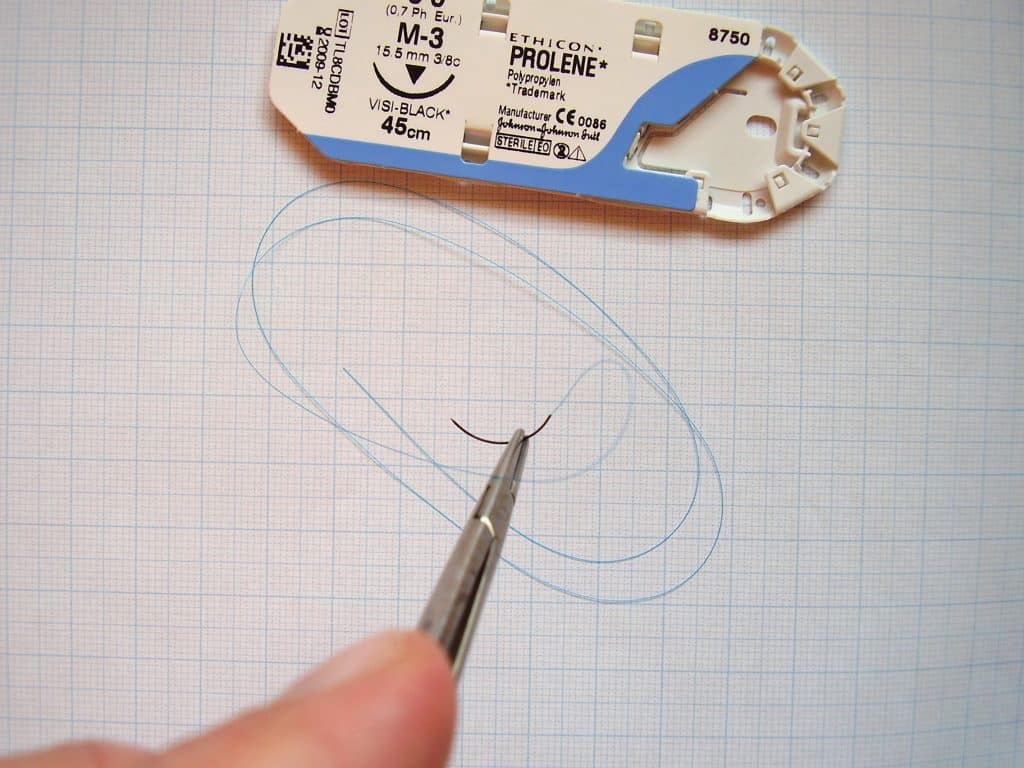Types of Surgical Sutures
Surgical sutures are medical devices used to hold body tissues together after an injury or surgery.
There are various types of surgical sutures and they are classified based on several factors such as absorbability, origin and structure of the surgical suture.
Sometimes, “sutures” are used interchangeably with “stitches”, however, it is important to note that “suture” is the name for the actual medical device used to hold body tissues together whereas “stich” refers to the act and the techniques used by the surgeon to close the wound.
Read More: How to Suture
Types of Surgical Sutures
There are various types of surgical sutures and they can be classified based on different parameters.
Based on Absorbability
All sutures are classified as either absorbable or non-absorbable depending on whether the body will naturally degrade and absorb the suture material over time.
1. Absorbable Sutures
This refers to surgical sutures that are broken down by the body by various biological processes including hydrolysis and enzymatic degradation and as such do not need to be removed at a later time. The process of degradation depends on the material and ranges from ten days to eight weeks.
Absorbable sutures are mostly used to suture internal body tissues.
Examples of Absorbable sutures are Catgut, Polydioxanone (PDS), Polyglactin (Vicryl) and Polyglycolic acid.
2. Non-absorbable Sutures
Non-absorbable sutures, as the name implies are surgical sutures that cannot be absorbed by the body as such need to be removed at a later time.
Sometimes, they are left in situ permanently. Non-absorbable sutures are used either on skin wound closure, where the sutures can be removed after a few weeks or in stressful internal environments where absorbable sutures will not suffice
Examples of non-absorbable sutures include Silk, Nylon, Polyester, Polypropylene. Also, Stainless steel wires are commonly used in orthopedic surgery and for sternal closure in cardiac surgery.

types of surgical sutures
Based on Origin
Surgical sutures can also be classified based on the origin of the raw material into natural and synthetic.
1. Natural Sutures
These are sourced from natural fibers made from biological materials. They are less frequently used, as they tend to provoke a greater tissue reaction.
Examples of natural surgical sutures are catgut sutures and silk.
2. Synthetic Sutures
These are sutures manufactured from chemical synthesis. They tend to be more predictable than the natural sutures, particularly in their loss of tensile strength and absorption.
Examples of Synthetic sutures include Nylon, Polyester, PDS, etc.
Based on Structure
Surgical sutures can also be classified based on the structure of the material.
1. Monofilament Sutures
The monofilament suture material is made of a single strand; this structure is relatively more resistant to harboring microorganisms. It also exhibits less resistance to passage through tissue than multifilament suture does.
However, great care must be taken in handling and tying a monofilament suture, because crushing or crimping of the suture can nick or weaken it and lead to undesirable and premature suture failure.
Examples of monofilament sutures are Nylon, Prolene, Polydioxanone (PDS).
2. Multifilament Sutures
The multifilament suture material is composed of several filaments twisted or braided together. It generally has greater tensile strength and better pliability and flexibility than monofilament suture material, and it handles and ties well
Examples of multifilament sutures are silk, vicryl, polyglycolic acid (PGA).
Based on Size
The tensile strength and handling properties are affected by the thickness of the suture thread. Suture materials are therefore manufactured in a variety of sizes.
Suture sizes are defined by the United States Pharmacopeia (U.S.P.). Sutures were originally manufactured ranging in size from #1 to #6, with #1 being the smallest. A #4 suture would be roughly the diameter of a tennis racquet string.
The manufacturing techniques, derived at the beginning from the production of musical strings, did not allow thinner diameters. As the procedures improved, #0 was added to the suture diameters, and later, thinner and thinner threads were manufactured, which were identified as #00 (#2-0 or #2/0) to #000000 (#6-0 or #6/0).
Modern sutures range from #5 (heavy braided suture for orthopedics) to #11-0 (fine monofilament suture for ophthalmics). Atraumatic needles are manufactured in all shapes for most sizes. The actual diameter of thread for a given U.S.P. size differs depending on the suture material class.
More:


